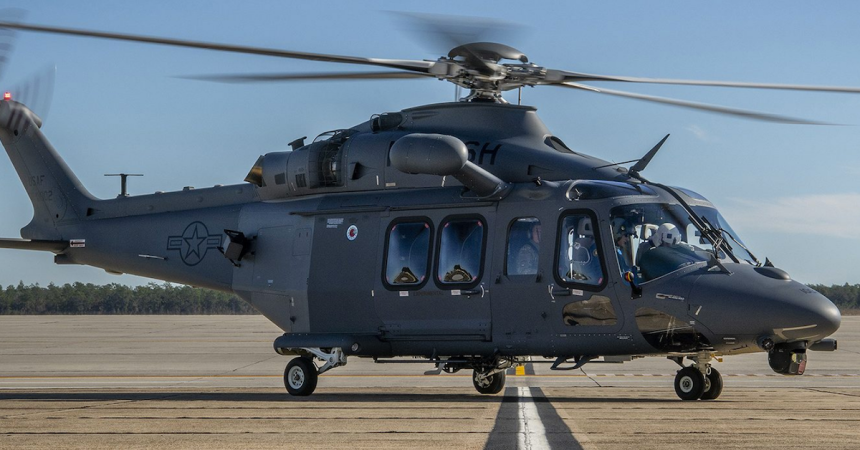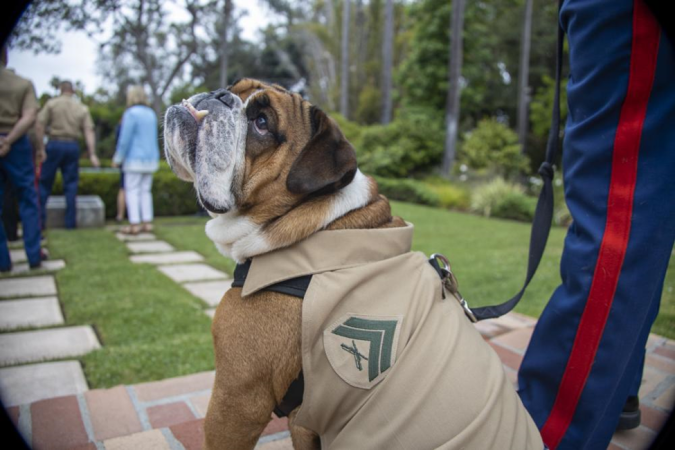
Gen. Abidin Ünal, Turkey’s Air Force Chief of Staff, waves during takeoff in a UH-1N Iroquois at Joint Base Andrews, Md., April 6, 2016. Ünal flew with the 1st Helicopter Squadron during a U.S. visit to build U.S. – Turkey relations. (U.S. Air Force photo/Senior Airman Ryan J. Sonnier)
On Apr. 6, Turkish Air Force Chief of Staff Gen. Abidin Ünal smiled and waved as the U.S. Air Force’s 1st Helicopter Squadron took him on an aerial tour of the Washington, D.C. area. What Ünal’s hosts probably never mentioned was that their “White Top” UH-1N Twin Hueys are getting dangerously old.
The flying branch bought their first Twin Hueys nearly five decades ago. Despite numerous attempts to replace the choppers, the UH-1Ns continue to fly security missions around nuclear missile fields, shuttle dignitaries around the nation’s capital and stand ready to help out after a disaster or other emergency.
“[The] UH-1N doesn’t satisfy many assigned mission requirements,” Air Force officials wrote in a presentation for defense contractors in August 2015. “Emphasis is on expedited fielding of replacement aircraft.”
We Are The Mighty obtained a redacted copy of this document through the Freedom of Information Act. According to the “rules of engagement” section, the hosts banned attendees from recording the industry day gathering or taking photographs.
First flown in 1969, the Bell UH-1N has a top speed just shy of 150 miles per hour and a range of over 300 miles. Compared to earlier Hueys, the N models have twin Pratt and Whitney T400-CP-400 turboshafts – hence the “Twin” nickname.
Depending on the internal configuration, the Twin Huey can carry up to 13 passengers in addition to its crew of three, at least on paper. Unfortunately, temperature and other weather conditions can dramatically change how much any helicopter can lift.
The briefing highlights three missions that were driving the push to replace the choppers. The first two were convoy escort and security response operations around missiles silos and related sites. The third, but equally important mission was carrying “distinguished visitors” like Ünal in and around Washington, D.C.

So, since the release of the Pentagon’s latest budget in February, and with serious concerns about these limits and overall age of the Air Force’s UH-1N fleet, American lawmakers have begun to demand action. But the safety of the country’s nuclear missiles has been at the center of the outcry.
“I look at the helicopters and I see glaring weaknesses and vulnerabilities which put our nation and … the mission at stake,” Ryan Zinke, a former Navy SEAL and Republic congressman for Montana, said in a statement on Mar. 9. “This is not a mission that can fail. Our nuclear triad is at stake.”
Armed with fast-firing miniguns and rocket pods, the Air Force originally rushed the UH-1Ns to Southeast Asia to schlep commandos around South Vietnam and Laos during the final years of the Vietnam War. By the end of the 1980s, the flying branch had largely replaced them in the special operations role with the more powerful HH-60G Pave Hawk.
Of the 62 UH-1Ns, 25 eventually wound up serving with squadrons guarding nuclear sites across the western U.S. The 582d Helicopter Group at F.E. Warren Air Force Base in Wyoming oversees those units and their missions.
However, nearly as many Twin Hueys are busy transporting “distinguished visitors” at home and abroad. The 1st Helicopter Squadron at Joint Base Andrews owns 20 of the choppers, while the 459th Airlift Squadron at Yokota Air Base in Japan has another four aircraft.
Commonly known as “White Tops” because of their striking blue and white paint jobs, the 1st Helicopter Squadron’s choppers fly foreign officials like Turkey’s Ünal around on a regular basis. On top of that, the unit is prepared to act if a natural disaster or major terrorist attack threatens the most powerful city in the free world.
In 2011, the 479th‘s white and gray UH-1Ns got put the test after the Tōhoku earthquake and resulting tsunami hit Japan. The choppers and their crews help moved critical American and Japanese personnel around the disaster area – including near the damaged Fukushima Daiichi nuclear power plant – to survey and assess the situation.
On Feb. 29, the Air Force announced that two of the Twin Hueys in Japan had gotten new hoists to help rescue trapped or injured individuals in a crisis. Unfortunately, on the same day, the service admitted that one of the UH-1Ns had made a “precautionary” landing at Chofu Airport in Tokyo after experiencing engine trouble.
“They’ve run an exercise, a couple of them, and every time they use the Hueys, they fail,” Zinke said in an interview with Congressional Quarterly in February, referring to some of the 582d’s aircraft stateside.
If a UH-1N were to crash while carrying an American or foreign government official, it would be a major embarrassment for the Air Force and Washington as a whole, if nothing else. Depending on who was involved and if there were any fatalities, the fallout could be just as devastating as a breach of nuclear security.
Unfortunately, Pentagon and the Air Force have had serious problems trying to fix the problem. Since 2004, the service has repeated pushed back the plans due to budget cuts, competing priorities and delays with other projects.

Had these sailors saved this Huey in ’75 (pushed overboard to make room on the flight deck during the evacuation of Saigon) it might still be flying VIPs around DC today. (Photo: U.S. Navy)
In 2009, the Pentagon dealt one of the biggest blows to the plan by canceling the program to replace the HH-60G rescue choppers. Three years earlier, the flying branch had hired Boeing to supply new HH-47 Chinooks.
Other competitors quickly filed official complaints accusing the service of mismanaging the contracting process. After the Government Accountability Office sided with the protesting companies, the Air Force tried and failed twice more to jump-start the program.
Ultimately, the flying branch inked a deal with Sikorsky to supply an updated HH-60W version of their iconic Black Hawk. But the Connecticut-based company, now part of Lockheed Martin, doesn’t expect to deliver any of those aircraft to the Air Force before 2019.
There’s no guarantee that these new aircraft would free up any of the older Pave Hawks either. In their 2015 briefing, the flying branch was willing to consider upgrading the choppers as a possible solution.
The Air Force made it clear that they wanted a single, common replacement for all the UH-1Ns scattered across the service, including another dozen assigned to training and test units. But, at the time, the presenters added that there was no program of record or funding stream for any replacements for the aging choppers.
On Feb. 26, Zinke and 13 other legislators co-signed letters to the House Armed Services Committee and the House Appropriations Committee asking them to put money for new helicopters in the 2017 budget. Their proposal would involve adding to an existing U.S. Army plan to purchase HH-60M Black Hawks, but sending the extra aircraft to the Air Force.
“By adding Black Hawks … we can address the problem immediately rather than more delayed action,” the messages explained. “Not only does the Huey create security vulnerabilities, it has been proven inefficient and costly to operate and maintain.”
Neither congress nor the Pentagon has made a final decision on how best to proceed. In the meantime, foreign officials like Ünal will have to continue riding in the old Twin Hueys when they visit Washington.










